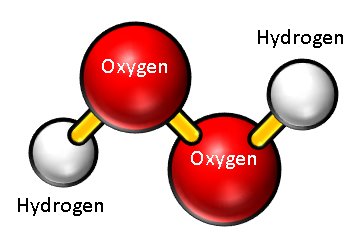A compound formed of 0.059 mol hydrogen and 0.94 mol oxygen has a molecular mass of 34.0 g/mole. What is the molecular formula of this compound?
1 Answer
Explanation:
As it turns out, the values given to you for the number of moles of hydrogen and oxygen present in a sample of this unknown compound are incorrect. More on that further down the page.
However, you can actually find the molecular formula of this compound without finding its empirical formula first, all you really need here is a periodic table.
So, the problem tells you that this unknown compound contains two elements, hydrogen,
As you know, a compound's molar mass tells you the mass of exactly one mole of said compound. In this case, one mole of your unknown compound will have a mass of
Now, take a look in the periodic table and make a note of the molar masses of hydrogen and oxygen
#"For H: " M_M = "1.00794 g mol"^(-1)#
#"For O: " M_M = "15.9994 g mol"^(-1)#
Notice that one mole of oxygen has a mass of
That is, one mole of your compound can contain a maximum number of two moles of oxygen, since you have
#2 color(red)(cancel(color(black)("moles"))) xx "15.9994 g" color(red)(cancel(color(black)("mol"^(-1)))) < "34.0 g" color(white)(a)color(green)(sqrt())#
#3 color(red)(cancel(color(black)("moles"))) xx "15.9994 g" color(red)(cancel(color(black)("mol"^(-1)))) > "34.0 g"color(white)(a)color(red)(xx)#
The compound cannot have one mole of oxygen per mole because the difference between the mass of one mole of oxygen and the mass of one mole of the compound cannot be accounted for by the hydrogen.
Why? Because you can't possibly form bonds between one mole of oxygen and approximately
#"34.0 g " - " 15.9994 g" = "18.0006 g"#
So, one mole of your unknown compound contains two moles of oxygen. The mass of hydrogen per mole of compound will be
#"34.0 g " - 2 color(red)(cancel(color(black)("moles O"))) * "15.9994 g"/(1color(red)(cancel(color(black)("mole O")))) = "2.0012 g"#
This is equivalent to
#2.0012 color(red)(cancel(color(black)("g"))) * "1 mole H"/(1.00794color(red)(cancel(color(black)("g")))) = 1.985 ~~ "2 moles H"#
Therefore, the compound's molecular formula, which tells you exactly how many moles of each constituent element you get per mole of the compound, will be
#"molecular formula" = color(green)(|bar(ul(color(white)(a/a)"H"_2"O"_2color(white)(a/a)|))) -># hydrogen peroxide

ALTERNATIVE APPROACH
Now, here's why I said that the values given to you for the number of moles of hydrogen and of oxygen are incorrect. To get the compound's empirical formula, find the mole ratio that exists between the two elements in the compound.
#"For H: " (0.059 color(red)(cancel(color(black)("moles"))))/(0.059 color(red)(cancel(color(black)("moles")))) = 1#
#"For O: "(0.94color(red)(cancel(color(black)("moles"))))/(0.059color(red)(cancel(color(black)("moles")))) = 15.93 ~~ 16#
This suggest that the smallest whole number ratio that exists between the two elements is
You cannot possible have more than two moles of oxygen per mole of this unknown compound.
Now, the problem would make sense like this
A compound formed of 0.059 moles of hydrogen and 0.094 grams of oxygen has a molecular mass of 34.0 g/mol.
In this case, you'd have
#0.94 color(red)(cancel(color(black)("g"))) * "1 mole O"/(15.9994 color(red)(cancel(color(black)("g")))) = "0.05875 moles O"#
You would now have
#"For H: " (0.059 color(red)(cancel(color(black)("moles"))))/(0.05875 color(red)(cancel(color(black)("moles")))) = 1.004 ~~ 1#
#"For O: " (0.05875color(red)(cancel(color(black)("moles"))))/(0.05875 color(red)(cancel(color(black)("moles")))) = 1#
The empirical formula would be
#color(green)(|bar(ul(color(white)(a/a)"H"_1"O"_1 implies "HO"color(white)(a/a)|)))#
The molar mass of the empirical formula would be
#1 xx "1.00794 g mol"^(-1) + 1 xx "15.9994 g mol"^(-1) = "17.007 g mol"^(-1)#
This means that you will have
#17.007 color(red)(cancel(color(black)("g mol"^(-1)))) xx color(blue)(n) = 34.0 color(red)(cancel(color(black)("g mol"^(-1))))#
#color(blue)(n) = 34.0/17.007 = 1.9992 ~~ 2#
Therefore, the compound's molecular formula will once again be
#("HO")_color(blue)(2) = color(green)(|bar(ul(color(white)(a/a)"H"_2"O"_2color(white)(a/a)|)))#

